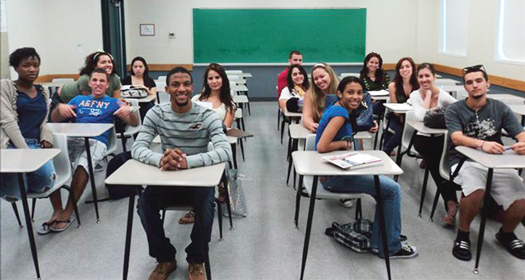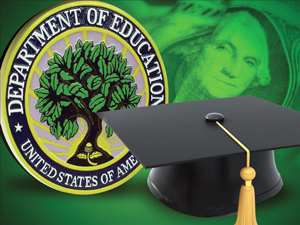New rules govern for-profit higher ed
By Nisa Islam Muhammad -Staff Writer- | Last updated: Nov 20, 2014 - 12:46:38 PMWhat's your opinion on this article?

The Department of Educations is proposing that for-profit colleges and training programs prepare students for “gainful employment” in a recognized occupation, instead of saddling them down with financial debt after college. The new regulations go into effect July, 2015. Photos: MGNOnline
|
WASHINGTON - The long awaited, controversial “gainful employment” regulations from the Department of Education targeting for-profit colleges and training programs—which leaves too many students saddled with debt and without jobs—say these institutions must curtail financial burdens students face or risk losing access to federal student aid.
These regulations, released to cheers and jeers, will hold career training programs accountable for putting their students on the path to success.
“Career colleges must be a stepping stone to the middle class, but too many hard-working students find themselves buried in debt with little to show for it. That is simply unacceptable,” U.S. Secretary of Education Arne Duncan said. “These regulations are a necessary step to ensure that colleges accepting federal funds protect students, cut costs and improve outcomes. We will continue to take action as needed.”

For-profit institutions target women, minorities and low-income individuals.
|
To qualify for federal student aid, the law requires that most for-profit programs and certificate programs at private non-profit and public institutions prepare students for “gainful employment in a recognized occupation.”
Under the regulations released Oct. 30, a program would be considered to lead to gainful employment if the estimated annual loan payment of a typical graduate does not exceed 20 percent of his or her discretionary income or 8 percent of his or her total earnings. Programs that exceed these levels would be at risk of losing the ability to participate in taxpayer-funded federal student aid programs.
The Association of Private Sector Colleges and Universities, representing over 1,400 institutions, has filed suit to stop the new rules. “This regulation, and the impact it will have on student access and opportunity, is so unacceptable and in violation of federal law, that we were left with no choice but to file suit. If successful, our suit will protect student access and opportunity to higher education at a time when the U.S. Department of Education seems interested in limiting choices for students by closing private sector programs,” said Steve Gunderson, association president and CEO.
The suit asks that a federal district court declare the regulation unlawful and to set it aside.
“While we seek relief from the United States District Court for the District of Columbia, we are hopeful that the Congress will stop the department’s regulation and consider the best interests of all students when they reauthorize the Higher Education Act and develop policies that apply to all students, in all programs, at all institutions,” added Mr. Gunderson.
The new regulations, which go into effect July 1, 2015, follow an extensive rulemaking process involving public hearings, negotiations and about 95,000 public comments.

|
Based on available data, the Education Department estimates that about 1,400 programs—nearly all for-profit institutions—serving 840,000 students would not pass the new accountability standards.
All programs will have the opportunity to make immediate changes that could help avoid sanctions, but if these programs do not improve, they would ultimately become ineligible for federal student aid—which makes up nearly 90 percent of revenue at for-profit institutions.
“It is imperative that this industry be held accountable for its role in the nation’s rising tide of student loan debt—now at over $1.2 trillion—and default faced by students enrolled in the for-profit sector. A majority of students who are targeted and victimized by the industry’s unscrupulous practices are women, minorities, low-income individuals, single parents, veterans and service members,” wrote Nancy Zirkin, executive vice-president of the Leadership Conference on Civil and Human Rights in a prepared statement.
“The rules also fail to protect students whose schools, like the Corinthian colleges, are suddenly closed down. A recent report from the Leadership Conference and seven other civil rights organizations describes many of these abuses and recommends much stronger measures to prohibit the ongoing exploitation of our communities by for-profit programs.”
According to the Department of Education, on average attending a two-year for-profit institution costs a student four times as much as attending a community college. More than 80 percent of students at for-profits borrow, while less than half of students at public institutions do. Students at for-profit colleges represent only about 11 percent of the total higher education population but account for 44 percent of all federal student loan defaults.
Maura Dundon, senior policy counsel at the Center for Responsible Lending, feels the regulations don’t go far enough. The main shortcomings are failures to address the outcomes of students who withdraw without getting a degree or certificate and the failure to consider student loan default rates, she said.
“Although default and the inability to graduate are the most serious risks faced by for-profit college students, the final rule dropped a provision that would have considered default rates of all program attendees,” she said.
“Instead, the rule considers graduates’ debt burden relative to their income, and does not consider the fate of students who leave without a degree,” she said in a statement. “But since a majority of for-profit college students are unable to complete their degrees, the decision to eliminate consideration of default rates has seriously weakened the rule.”
The Education Department is working on a new college ratings system that will showcase colleges and universities that are effective in improving student success; incentivize institutions to work toward the most important goals, like graduating low-income students and holding down costs; and help students and families choose their school based on the value it provides for their investment, said federal officials.
INSIDE STORIES AND REVIEWS
-
-
About Harriett ... and the Negro Hollywood Road Show
By Rabiah Muhammad, Guest Columnist » Full Story -
Skepticism greets Jay-Z, NFL talk of inspiring change
By Bryan 18X Crawford and Richard B. Muhammad The Final Call Newspaper @TheFinalCall » Full Story -
The painful problem of Black girls and suicide
By Charlene Muhammad -National Correspondent- » Full Story -
Exploitation of Innocence - Report: Perceptions, policies hurting Black girls
By Charlene Muhammad -National Correspondent- » Full Story -
Big Ballin: Big ideas fuel a father’s Big Baller Brand and brash business sense
By Bryan Crawford -Contributing Writer- » Full Story






 Click Here Stay Connected!
Click Here Stay Connected!








